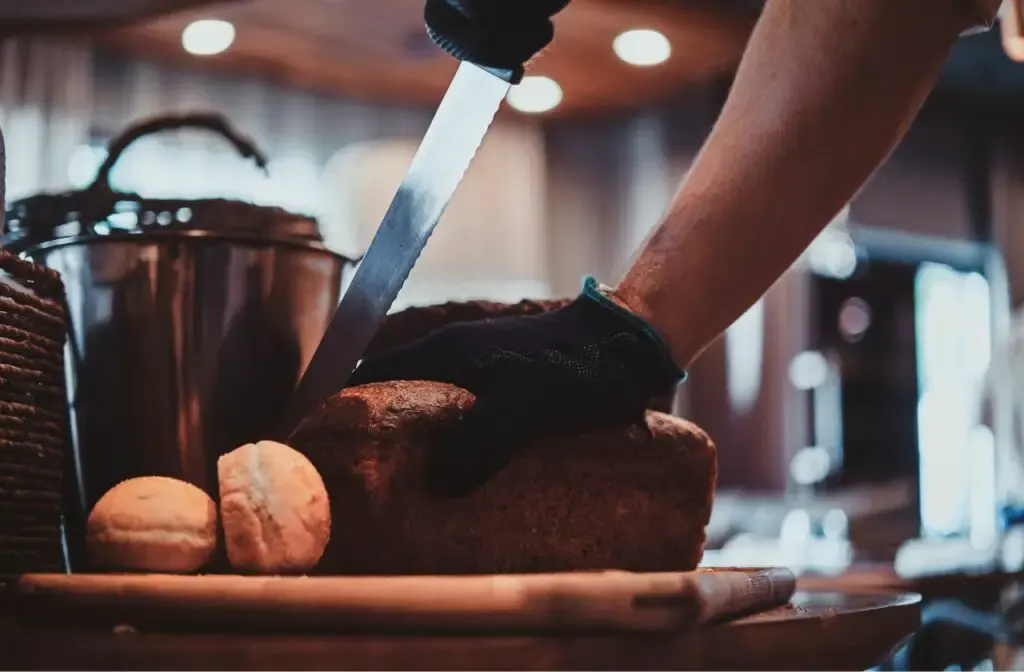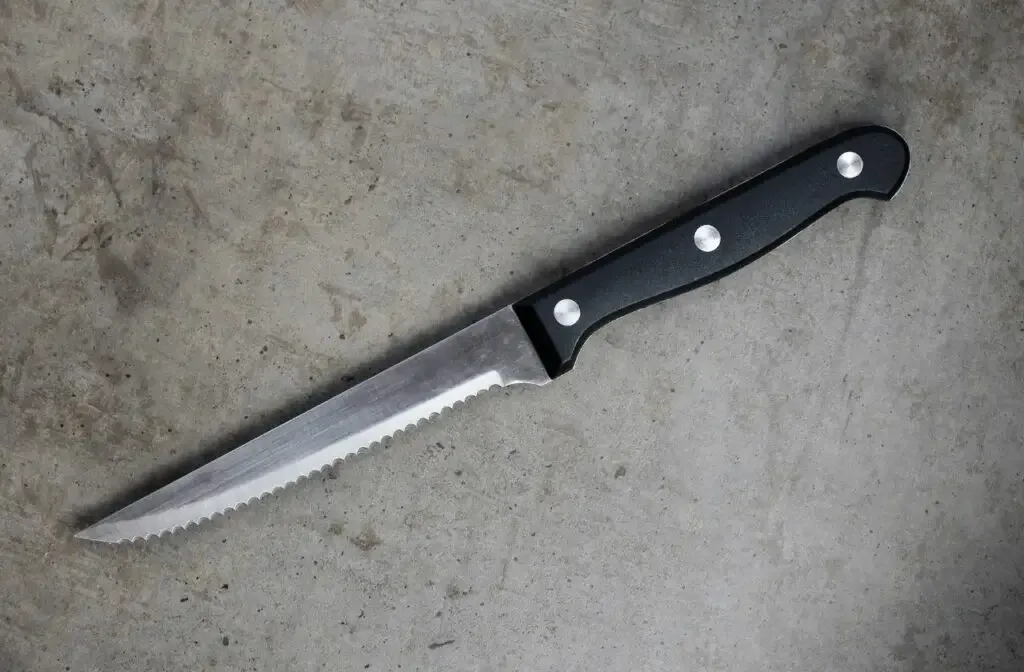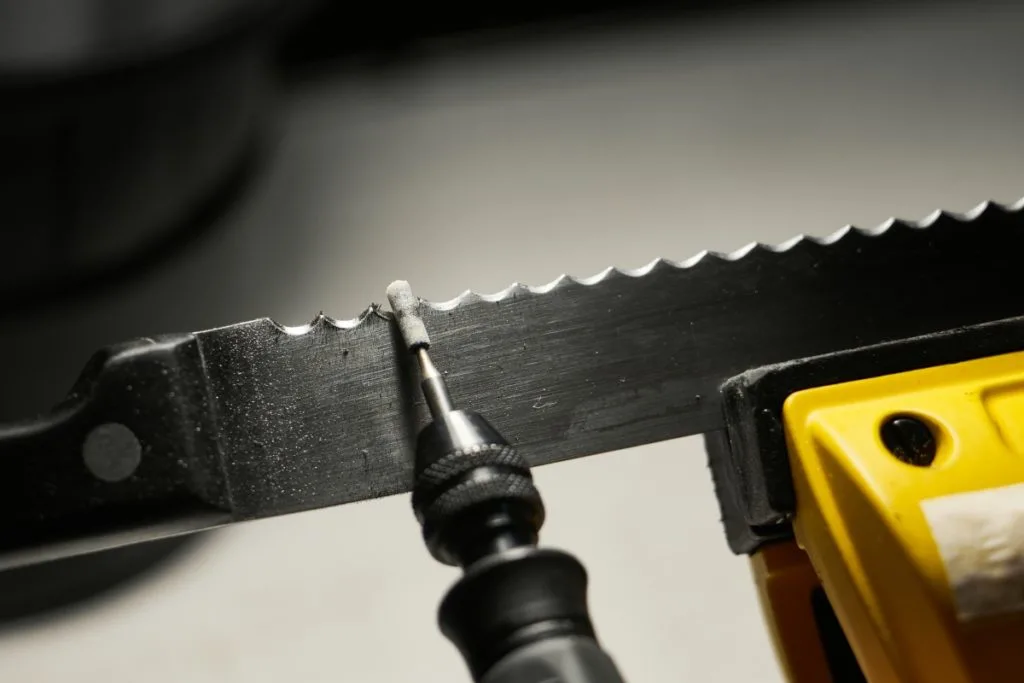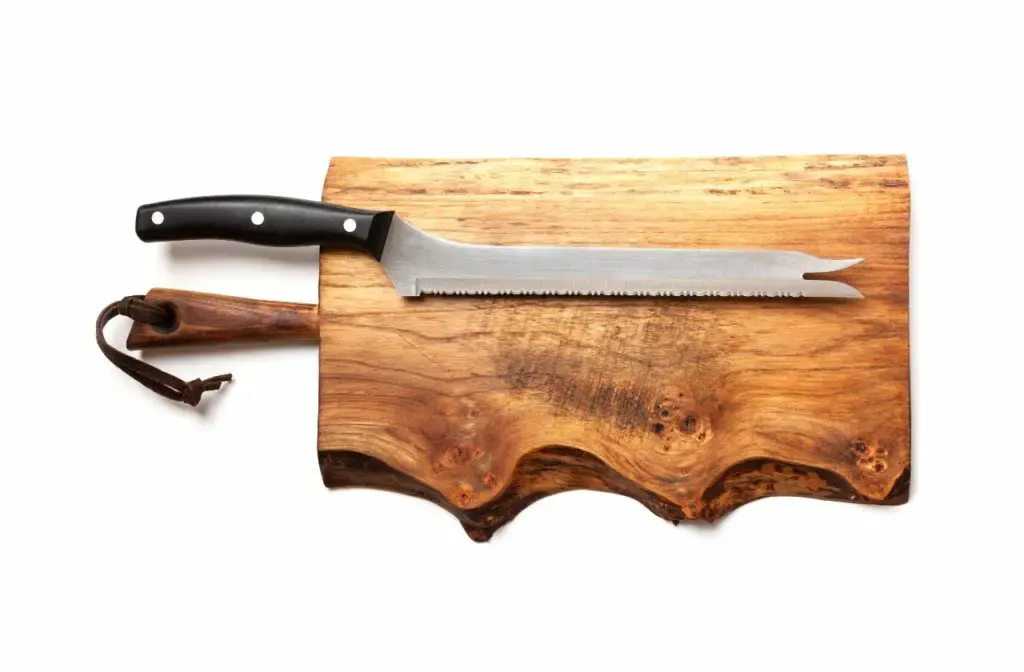As an Amazon Associate, we earn from qualifying purchases with no additional costs for you.
Serrated blade knives have an advantage in how long they stay sharp, but the knife will need sharpening at some point. This dilemma poses a head-scratching moment for many knife owners since sharpening a serrated blade can be challenging compared to straight-edge knives.
A serrated blade cannot be sharpened effectively with a flat whetstone typically used for straight-edge knives. A tapered diamond sharpening rod is the best tool to sharpen a serrated blade. The tapered rod perfectly fits the curved bevels in the serration for effective sharpening.
If you have a serrated knife that needs sharpening but is not sure where to start, we can guide you through the process, what tools you will need, and the techniques needed to restore the edge on your knife.
If you are interested in checking out the best sharpeners for serrated knives you can find them by clicking here (Amazon link).

Can Serrated (Bread) Knife be Sharpened?
Serrated knives have a long-lasting edge, but the edge will deteriorate over time with normal use. If you have a quality serrated blade, you will opt to sharpen the edge rather than replace the knife with a new one.
Some knife owners may not know that a serrated blade can be sharpened, but it is certainly possible to sharpen them. It is not as difficult as you may expect to sharpen these blades. The process is slightly different from sharpening a straight edge knife and takes a little more concentration, but it is well worth the effort!
Even though sharpening a serrated blade requires a little more attention to detail, it is not so much that the process should be discarded as a viable option. Sharpening a serrated blade can be easier than sharpening a straight edge, provided that you have the right tools to do the job.
We will discuss the tools that can be used to sharpen serrated blades and if you can use standard sharpening tools on these blades.
Do You Need To Sharpen Serrated (Bread) Knives?

While the edge geometry of a serrated blade is different from that of a straight edge, the cutting edge is still subject to wear over time.
The edge retention on a serrated blade is excellent, but sharpening will be necessary when the knife has been well used. It may take a few years before a serrated blade requires sharpening, depending on the frequency of use.
Some serrated knife manufacturers claim that their knives never require sharpening. This statement is a marketing ploy since all knives wear with use and will require sharpening at some stage to restore the cutting edge.
TIP: Most people know what a bread knife is and what it looks like, and many people who do not understand its use may consider it redundant in the kitchen. Find out what to cut and not to cut with a serrated knife in the article below:
What To Cut & NOT To Cut With A Bread (Serrated) Knife
How To Sharpen A Serrated Knife With A Whetstone

A whetstone is traditionally a flat, rectangular block with sharp 90° edges. If you look at a standard whetstone and compare the surface to the scalloped edges on a serrated blade, you will quickly conclude that this tool will not work in its standard form.
Whetstones make for an exceptional sharpening tool for flat blades but cannot accommodate the curves between the teeth of the serrations. To properly sharpen a serrated blade, you need to address the curved surface of the serration for optimal sharpness.
Some people suggest modifying a whetstone by rounding one of the corners of the whetstone with a file to accommodate the scalloped edge of the serrated knife. I have several problems with this approach.
The first is you can potentially destroy a perfectly good and possibly expensive whetstone. Secondly, you can only make one size radius on the corner, which will only accommodate knives with serrations of that radius. Some serrated knives have scallops of different radii on the same edge.
Lastly, this approach will not be feasible if you have diamond whetstones since the baseplate is usually made from metal. Likewise, ceramic whetstone edges cannot be rounded in this way due to the nature of the ceramic material.
The only way to use whetstones to sharpen a serrated blade is to use a specially shaped whetstone to perform the sharpening. However, these tools are generally not called whetstones, even though they can be made from the same material as whetstones.
Some manufacturers produce sharpening stones in a triangular format, which provides better access to the curves in the serrations. However, these corners are often also too acute to fit the serration curves correctly. This poor fit makes the sharpening job more tedious and cumbersome than it needs to be.
TIP: Are you looking to buy a new whetstone? Check out our recommendations (we personally use the first three ones):
Our PRO choice whetstones combo (Amazon links):
- Fixing stone: Whetstone SHAPTON Ceramic KUROMAKU #320
- Sharpening stone: Suehiro CERAX soaking whetstone: Medium #1000
- Finishing stone: Whetstone SHAPTON Ceramic KUROMAKU #5000
Our budget choice (Amazon link): Sharp Pebble Extra Large Sharpening Stone Set
How To Sharpen A Serrated Knife With An Electric Sharpener

Many people like electric knife sharpeners for the convenience these machines offer for this task. Electric knife sharpeners generally do not require the knife owner to have any specialized knowledge regarding knife sharpening. But will electric sharpeners work for serrated blades?
Electric sharpeners will sharpen some serrated knife blades, but not all. Electric sharpeners are mostly designed for kitchen knife sharpening. Consequently, they work for sharpening serrated edge knives such as bread knives with standard and uniform serrations.
It should be noted that not all electric sharpeners offer an option for sharpening serrated knives. You should never try to sharpen your serrated bread knife on an electric sharpener that does not specify it can sharpen these blades. Sharpening a serrated edge on a sharpener not designed for the purpose can ruin the knife.
Electric sharpeners are generally pull-through sharpeners, with a motor that drives the abrasive surface that does the sharpening. Some electric sharpeners will have a separate sharpening “slot” to be used with serrated knives. This slot will have a differently shaped abrasive to sharpen the serrations on the blade.
Follow these steps to sharpen your serrated knife with an electric sharpener.
- Plug the sharpener into an electrical outlet.
- Establish which slot is used for serrated knives.
- Switch the power on.
- Pull the knife through the sharpening slot 2 or 3 times.
It should not take more than a few passes in the sharpener to re-condition the serrated edge and restore the knife to being sharp once again.
Limitations Of Electric Sharpeners
Electric sharpers are easy to use and convenient, but they have limitations, especially concerning serrated knife blades.
Electric sharpeners have fixed sharpening mechanisms that can only offer limited adjustments, meaning they cannot cater to a wide range of serration sizes for sharpening.
Many bushcraft knives or pocket knives that have either full or partial serrations on the blade do not have regular, uniformly sized serrations. These knives cannot be sharpened on an electric sharpener designed to sharpen a serrated bread knife.
The only effective sharpening method for a serrated knife with irregular serrations is to use a sharpening rod.
TIP: Electric knife sharpeners may seem like a fast and effective method to sharpen knives, but do they ruin your knives? Check out the explanation in the article below:
Explained: Do (Electric) Knife Sharpeners Ruin Knives?
How To Sharpen A Serrated Knife With A Rod
By far, the best method to sharpen any serrated knife, including a bread knife, is with a sharpening rod designed for the purpose.
A sharpening rod for serrated blade sharpening is usually a tapered rod made from a sharpening abrasive capable of cutting the steel.
The taper in the rod is the key factor to look for in a rod for serrated knife sharpening. The taper allows the rod to fit a wide range of serration sizes, giving greater versatility in the types of serrated blades you can sharpen with the tool.
Several varieties of sharpening rods are available for sharpening serrated blades and can include the following.
- Diamond sharpening rods. These are tapered rods, usually with aluminum as the base, coated with diamonds as the abrasive to do the sharpening work. The rods come in a variety of grits, usually coarse, medium, and fine, depending on the level of repair the blade needs.
- Ceramic sharpening rods. Ceramic sharpening rods are very effective serrated blade sharpeners but are only recommended for touching up edges that are already sharp rather than sharpening a dull knife.
- Stone sharpening rods. Some manufacturers produce sharpening rods from the same material as whetstones. These work in the same way as the other rods but come in a wider range of grits. However, you mostly only need coarse, medium, and fine grit to accomplish the most sharpening tasks for a serrated edge. These rods will require lubrication with either water or oil to be effective.
The most versatile sharpening rods are the diamond rods, which can be used dry and have superior cutting ability over the other rod types.
Diamond rods can also be used on straight-edge knives with some success, so long as you maintain the correct angle throughout the sharpening stroke.
Using a diamond rod to sharpen a serrated blade is a relatively easy task and does not take an exceptionally long time since the serrations generally don’t require much work to become sharp.
Follow these steps to sharpen a serrated edge knife with a diamond rod.
- Position the knife. It is best to work with the spine of the knife towards you and the sharp edge away from you so you can push the rod towards the cutting edge of the bevel.
- Find the diameter that matches the scallop. Place the diamond rod on the scallop and find the portion of the rod that best matches the radius of the bevel.
- Establish the correct angle. Position the rod at an angle that will make contact on the bevel all the way down to the cutting edge.
- Use short strokes with minimal pressure. Push the rod through the serration a short distance in the direction toward the cutting edge. Do not go too far on the rod, as the wider part of the rod will extend the serration size. Don’t use a section of the rod that is too thin; this will wear a groove in the bevel.
- Use 2 to 3 strokes on each serration. Pass the rod across each serration 2 or 3 times and check the edge for sharpness. Only perform more strokes if necessary.
- If a burr has developed on the flat side, strop the flat side. The flat side can be passed once or twice at a very flat angle across the length of the diamond rod to remove a burr that formed during the sharpening of the bevel side.
A serrated knife does not require frequent sharpening, and depending on how the knife is used, you may only need to touch up the edge every six months to a year. Of course, knives that see heavier use may require more frequent attention to keep the edge sharp.
TIP: Sharpening and honing are two knife-sharpening terms that fall into a grey area of lack of understanding. Check out the what the differences between sharpening and honing are in the article below:
Sharpening vs. Honing: Simple Explanation & Differences
FAQ: Can Serrated Steak Knives be Sharpened?
Serrated steak knives typically have smaller serrations than bread knives, but the serrations are usually uniform. This allows for relatively easy sharpening with the right tools.
Serrated steak knives can be sharpened fairly easily using a tapered sharpening rod. We recommend a ceramic or a diamond tapered sharpening rod (Amazon link) for the best result in sharpening these knives.
It generally only requires 2 or 3 passes if the tapered rod in each serration to restore the edge to take on any steak-cutting task!
FAQ: Do You Need a Special Sharpener for Serrated Knives?
Many people like to DIY their knife sharpening and attempt to sharpen serrated edge knives on standard sharpeners. The results from these sharpening attempts will be mediocre at best.
Special sharpeners are required to properly sharpen serrated edge knives. Standard sharpeners are too flat or have sharp corners and cannot access the curved area in the serrations to adequately sharpen the curve and the inside edges of the teeth of the serration.
If you do not have a sharpening rod, you can achieve the same effect by wrapping sandpaper around a tapered round file to mimic a sharpening rod. You can change up the sandpaper grit depending on the level of sharpening the knife requires.
FAQ: Can You Strop Serrated Knife?
Stropping is recommended for finishing the sharpening process on a knife to kick the sharpness up a level as the final step.
A serrated knife can be stropped, but only on the flat side of the blade. Stropping on the beveled side of the serrations will have no effect on the edge since the strop will not make contact with the bevels. Stropping the flat side will help but offers minimal improvement to sharpness.
The strop will polish the flat side of the serration and remove any burr developed on this side during the sharpening process. This will help sharpen the knife further, but stropping alone will have limited success in sharpening a dull knife.
BTW: If you want to know more about Japanese and other knives and their sharpening, check out the books listed above. These books are recommended by professional sharpeners and knife makers (Amazon links):
- Japanese Kitchen Knives: Essential Techniques and Recipes
- The Knifenerd Guide to Japanese Knives
- Knife: The Culture, Craft, and Cult of the Cook’s Knife
- Sharp: The Definitive Introduction to Knives, Sharpening, and Cutting Techniques, with Recipes from Great Chefs
The Importance of Keeping a Serrated Knife Sharp

A serrated knife, often recognized by its wavy or toothed blade, is a staple in many kitchens and toolkits. While its unique design allows it to cut even when somewhat dull, maintaining its sharpness is crucial for both functionality and safety.
Let’s explore into the significance of keeping your serrated knife in tip-top condition.
Advantages of a Sharp Serrated Knife
Efficiency and Precision: A sharp serrated knife ensures clean and precise cuts, whether you are slicing bread, tomatoes, or even delicate pastries. The sharper the knife, the less effort you need, making your tasks quicker and more efficient.
Safety: Contrary to popular belief, a sharper knife is safer. A dull blade requires more pressure, increasing the chances of the knife slipping and causing an injury.
Longevity: Regularly sharpening and maintaining your serrated knife can extend its lifespan. A well-maintained knife reduces the wear and tear on its blade, ensuring you get the most out of your investment.
Enhanced Food Flavor: When slicing food, especially fruits and vegetables, a sharp knife prevents cellular damage. This means the flavors, juices, and textures remain intact, enhancing the overall taste and presentation.
Drawbacks of a Dull Serrated Knife
Inconsistent Cuts: While the serrations can still tear through items even when dull, the cuts will be uneven and ragged. This can affect the presentation of your dishes and the consistency of your preparations.
Increased Effort: A dull knife demands more force, leading to fatigue, especially during prolonged use.
Potential for Damage: Using a dull serrated knife can lead to unintentional damage. For instance, when slicing bread, you might end up squishing it rather than getting a clean slice.
Safety Concerns: As mentioned, the extra pressure needed for a dull knife increases the risk of accidents.
Conclusion
Sharpening a serrated knife, be it a bread knife or a bushcraft knife with partial serrations, is not only possible but not as difficult as most people imagine.
The key to sharpening a serrated knife is to use the correct tools for the sharpening task. The right tools will make the process easy and ensure you have a good sharp edge on the blade once the job is done!
Get yourself a tapered diamond rod, and you will have all your serrated knives back to a perfect cutting condition in no time!
TIP: So you already know how to sharpen a serrated knife. If you are interested in buying the best sharpeners for serrated knives, check out the tips in the article below:
TOP 7 Knife Sharpeners For Serrated Knives: Complete Guide

